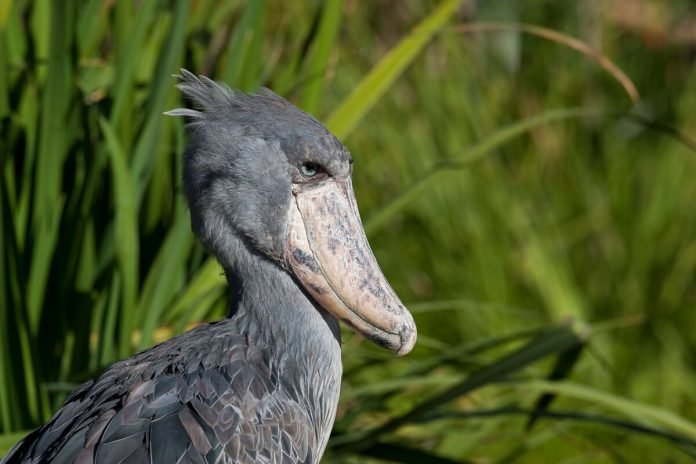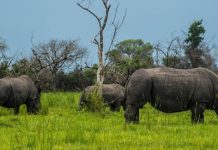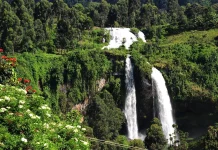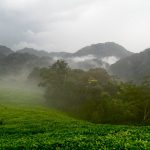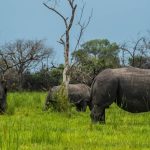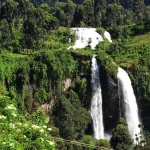In the heart of eastern Africa, Uganda harbors unique tropical forests, savannah, Africa’s highest mountains and an incredible amount of wildlife. It is a land of endless potential for the wildlife enthusiast. From great herds of elephants of the open savannah to an incredible abundance of birdlife, from the depths of a tropical rainforest to the depths of Lake Victoria and river Nile teeming with fish, Uganda is a treasure trove of natural wonders.
The country’s dramatically diverse geography has resulted in an enormous range of natural habitats, making Uganda one of the natural wonders of the world. Famous worldwide for its great friendly people and cultural centers, Uganda is also a stunningly diverse destination for birding and natural history. Uganda could keep a birder busy for a lifetime.
A remarkable composition of habitats in a relatively condensed area includes islands, mountains, forests, woodlands, wetlands and savannah. With 11% of the world’s species and over half of all bird species in Africa -over 1000 different varieties, Uganda’s birding is one of the best in the world. What a haven for birders and magnificent birds!
You are welcome to Uganda as it is safe and comfortable for travelers with excellent food and accommodation. Africa adventure safaris have more comprehensive tours, allowing time to properly see all species, including the more common and widespread birds that may be lifers for birders yet ignored by other tour operators. There are both migrant and breeding birds a person could reasonably expect to see in a sensible, fun designed itinerary to produce many special and exotic species of birds. Migrant birds are present from November to April. Many other sought-after birds are easily seen on several tours, and there are excellent chances to observe a number of classic and scarce tropical birds.
It holds some of the most remarkable birding sights to be seen anywhere! Come with us and you will bear witness to an array of unbelievable spectacles. From the world’s biggest bird (the Ostrich) to the endemic birds like Fox’s weaver and Stuhlmann’s double-collared sunbird to the most numerous of all birds , Uganda has a truly impressive variety and quantity (over 1000 species recorded) of bird species.
Best places for birding in Uganda
Uganda enjoys a favorable climate year-round, thanks to its abundant water sources and diverse vegetation, making it one of the best birding destinations in Africa. Birds from various parts of the world, including South Africa, Asia, and the USSR, migrate to Uganda throughout the year, adding to the country’s rich avian diversity. With a recorded count of approximately 1080 bird species, Uganda offers ample opportunities for bird watching.
Birding enthusiasts can explore Uganda’s national parks and forests, where a wide variety of bird species reside. Additionally, boat rides along the country’s water bodies provide excellent opportunities to spot numerous birds along the banks. Here are some of the top birding spots in Uganda:
Mabamba swamp
The protected area is situated on Lake Victoria and stands as one of the few places where the rare Shoebill Stork can be found. Other notable bird species include African and Lesser Jacanas, Pied Kingfisher, African Pygmy Goose, and Blue-breasted Bee-eater.
Murchison falls national park
This is Uganda’s largest national park, hosting 451 bird species. Some of these birds can be seen during game drives or boat cruises at the bottom of the falls. Among them are water birds, Albertine Rift endemics, and savanna forest birds. The Shoebill is a major bird attraction along the Albert Delta boat ride. Other notable birds include the Hamerkop, Rock Pratincole, Martial Eagle, Hugli’s Francolin, Dark Chanting Goshawk, and White-faced Whistling Duck.
Bwindi Impenetrable national park

The park is renowned for gorilla trekking, but birdwatching is also a popular activity with 350 bird species. It is home to Albertine Rift endemic birds and forest birds. Some of these avian inhabitants include Sherry’s Crimsonwing, Black-billed Turaco, Handsome Francolin, Purple-breasted, Blue-headed, and Regal Sunbirds, Western Bronze-naped Pigeon, White-bellied Robin Chat, Fraser’s Eagle, Mountain Masked, and Collared Apalis. You can spot these birds during gorilla trekking and nature walks.
Mgahinga National park
The park is situated in southwestern Uganda and is home to 180 bird species, some of which are Albertine Rift endemic birds. Among these avian residents are the Stripe-breasted Tit, Brown Woodland Warbler, Cape Robin, Greater Collared Sunbirds, Olive Pigeons, Western Green Tinkerbird, Rwenzori Batis, Archer’s Robin Chat, White-starred Robin, Kivu Ground Thrush, Brown-crowned Tchagra, and Scarlet-tufted. You can spot these birds during the tracking of the Nyakagezi gorilla family and nature walks in the forest.
Kibale forest national park
Kibale Forest is one of the best bird-watching destinations in Uganda, boasting over 350 bird species. In addition to chimpanzee tracking, bird watching is also popular here, thanks to the dense vegetation cover that supports diverse bird life. Some of the birds you can spot include the Great Blue Turaco, Papyrus Gonolek, Yellow-billed Barbet, Crowned Eagle, Papyrus Canary, White-winged Warbler, and Yellow-billed Barbet. These birds can be found in Bigodi Wetland, Magombe Swamp, and Kanyanchu.
Queen elizabeth national park
This is one of the most visited national parks in Uganda, and it is home to 600 bird species along with a variety of mammals.In Queen Elizabeth National Park, you can find a diverse range of birds, from those that live in forests and woodlands to the impressive 54 species of raptors. Additionally, there are water birds and migratory birds, adding to the park’s rich avian diversity. The park has many sectors, and each sector harbors different bird species. For instance, Mweya Peninsula has over 70 species, the Kasenyi area has 60 species, Lake Kikorongo, Katunguru Bridge, Ishasha sector, Kyambura Gorge, Katwe area, Maramagambo Forest and lake Munyanyange with flamingos.
Some of the birds you can find include the Black-lored babbler, Grey kestrel, martial eagle, African wattled plover, white-tailed lark, hooded vulture, and black-bellied bustard. Most of these bird species can be encountered during game drives and boat cruises at the Kazinga Channel. As you explore the park’s different sectors, you’ll have the opportunity to observe these beautiful bird species in their natural habitat.
Lake mburo national park
In addition to the impalas and zebras, Lake Mburo National Park is home to 351 bird species, which are commonly found in the marshy areas of Miriti at the salt lick, Rubanga and Warukiri forests, around the landing sites, and the Rwonyo camp. These birds include the grey crowned crane, coqui francolin, green wood-hoopoe, white-headed barbet, common scimitarbill, rufous-bellied heron, rare red-faced barbet, and bateleur.
These birds can be spotted during a boat cruise on Lake Mburo, game drives, and nature or community walks in the park. As you explore the park’s diverse habitats, you’ll have the opportunity to observe these beautiful avian species in their natural environment. So, don’t forget to bring your binoculars and camera to capture the stunning sights and sounds of the birds of Lake Mburo National Park.
Semliki national park
Nestled within the Albertine Rift Valley, the park is a treasure trove for bird enthusiasts, boasting an impressive diversity of avian species. With over 441 bird species, it offers ample opportunities for birdwatching in stunning natural surroundings.
The park’s most famous attraction is the Sempaya Hot Springs, renowned for their therapeutic waters and captivating geological features. These hot springs attract visitors from far and wide, offering a unique experience amidst the park’s lush landscapes.

Many of the park’s bird species can be found in the Semliki Riverine Forest, along the banks of the River Kirumia, and in the Ntandi area. Among these species are the Xavier’s greenbul, Ross’s turacos, Great Blue, Yellow-throated Nicator, Red-billed Dwarf Hornbill, and Western Bronze-naped Pigeon.
Budongo forest
Nestled on the edge of the Albertine Rift Valley within Murchison Falls National Park lies the forest reserve, a haven for wildlife enthusiasts and bird watchers alike. With its diverse ecosystem, the reserve is home to an impressive array of flora and fauna, including over 350 species of birds.
Among the inhabitants of the forest are chimpanzees, along with other primate species such as olive baboons, red-tailed monkeys, and black and white colobus monkeys. These primates add to the richness of the reserve’s biodiversity, offering visitors the opportunity to observe these fascinating creatures in their natural habitat.
For bird enthusiasts, the forest reserve is a paradise. With its varied habitats and abundant food sources, it supports a diverse avian population. Some of the bird species that call this forest home include the spotted greenbul, blue-throated roller, rufous-crowned Elemomela, white-thighed hornbill, chocolate-backed kingfisher, fire-crested Alethe, and blue-breasted kingfisher.
Rwenzori mountains
Located in western Uganda, the park boasts six massifs, each separated by deep gorges, creating a stunning landscape. But it’s not just the scenery that attracts visitors, the park is also home to a remarkable array of bird species. In fact, there are a total of 177 different types of birds that call this park their home.
Among these avian residents are some truly captivating species. From the colorful Rwenzori Turaco to the majestic Black Eagles and Bearded Vultures, the park offers birdwatchers a chance to spot a diverse range of feathered friends. Other notable species include the Long-eared Owl, Cinnamon-chested Bee-eater, Ladens Bush-shrike, and the Slender-billed Starling.
For those keen on birdwatching, mountain climbing in the park provides an excellent opportunity to catch a glimpse of these magnificent creatures. As you ascend the massifs, keep your eyes peeled for the White-starred Robin, Archer’s Robin Chat, and the stunning Golden-winged and Blue-headed Sunbirds.
Lutembe bay
Lutembe Bay, located in the Lake Victoria Basin, is a haven for millions of birds, both migratory and indigenous. This area serves as a habitat for over 200 different bird species, offering a diverse and vibrant ecosystem for avian life. Among these species, 26 are migratory, traveling from the Palearctic region to Lutembe Bay for various reasons.
Some of the notable migratory birds found in Lutembe Bay include the African Pygmy Kingfisher, Holub’s Golden Weaver, White-winged Black Tern, African Green Pigeon, Lead-colored Flycatcher, Sooty Chat, Tropical Boubou, and Brown-backed Scrub Robins. These birds, along with many others, contribute to the rich biodiversity of Lutembe Bay, making it a prime destination for birdwatchers.
Uganda’s top bird species
In Uganda, there are special places where you can find certain birds. Luckily, Uganda has many of these spots for people who love birds. If you go on a birding trip, you can see these lovely species. An expert bird watcher can spot over 100 different kinds of birds in just one day. It’s best to start your bird watching early in the day. This gives you the best chance of seeing some really remarkable and beautiful birds. These are the top bird species that are found in Uganda.
The orange fox weaver is a unique bird found only in Uganda, specifically in the northeastern region between Lake Opeta and Bisina, south of the Pian Upe Wildlife Reserve.
The shoebill stork is commonly found in marshy areas, such as the Albert Delta side of Murchison Falls National Park, Lake Mburo National park, Makanga bay and Mabamba Swamp.
Shelley’s crimson wing is a bird native to the Albertine Rift Valley and is primarily found in Bwindi Impenetrable National Park.
The Rwenzori turaco is another bird from the Albertine Rift Valley, commonly spotted in the Rwenzori region. It’s known for its distinctive red head.
The African green broadbill is another bird unique to the Albertine Rift Valley, specifically located in Bwindi National Park within the Ruhija and Buhoma sectors.

The Doherty’s bush shrike is also found in Bwindi Impenetrable National Park.
The green-breasted pitta is found in Kibale National Park.
The black-breasted barbet is a bird native to the Albertine Rift Valley, specifically found in Bwindi Impenetrable National Park.
The bar-tailed trogon can be found in both Bwindi Impenetrable National Park and Mabira Forest.
The short-tailed warbler is another bird species that can be found in Bwindi Impenetrable National Park.
The standard-winged nightjar is a bird that is found only in Queen Elizabeth National Park.
Although Uganda has only two Endemic birds (Fox’s weaver and Stuhlmann’s double-collared sunbird), 23 Albertine Endemics occur here and are difficult or even impossible to find somewhere else including rare and localized Shoebill, rare and near-endemic Red-throated alethe, Black-headed lapwing, African jacana, Yellow-throated long claw, African green broadbill, Dwarf Honey guide, Archer’s robin-chat, Blue-headed sunbird, Chapin’s flycatcher, Hartlaub’s turaco, Ruwenzori Batis, Ruwenzori Nightjar, Ruwenzori Turaco and Yellow-eyed black flycatcher. Travelling for birding safari in Uganda is good all-year round so you can visit any time of the year!
Things to carry during your birding safari in Uganda
It’s essential to pack the right gear for your birding safari in Uganda. Make sure to bring along long-sleeved shirts and trousers to protect yourself from the elements, as well as binoculars, a map of the location, drinking water, and a photography camera. While birding can be enjoyed year-round, weather conditions may affect your experience. The best time for bird watching is during the dry season, from January to February and June to August. During these months, trails are dry and easier to navigate, allowing for uninterrupted bird watching.
The period from May to September is also excellent for birding, as there is less rain, and food for birds is abundant. From November to April, migratory birds can be found in Uganda’s national parks, adding to the diversity of species.
For optimal birding, mornings are the best time of day, as bird activity tends to be highest during this time. Keep in mind that parks may be crowded during the high season, so planning your visits accordingly can help you avoid crowds and maximize your birding experience.
In addition to birding, Uganda offers a wide range of adventurous and exciting activities, such as mountain gorilla trekking, chimpanzee trekking, and mountain climbing. Many birding itineraries include these activities, allowing visitors to enjoy a diverse array of experiences during their time in Uganda.
